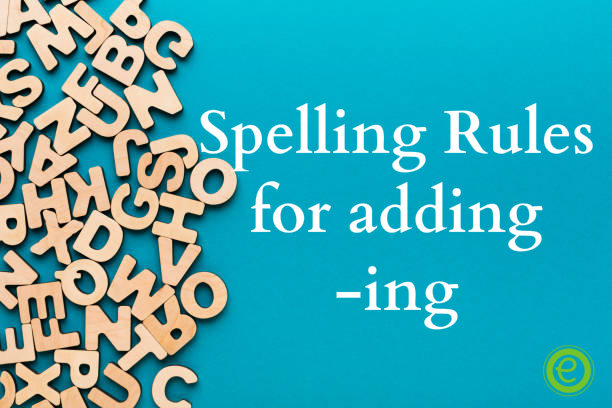In English grammar, we use a lot of suffixes which are added to the main verb. This verb then gets modified and will change the meaning of the entire sentence in which it is used.

In this session, we would be discussing the spelling rules which will help in understanding the concept when we try to add suffix -ing in the end. Let’s get to know some of the spelling rules which are applicable when you try to use suffix “-ing” in the verb.
Spelling Rules for Adding -ing
The two -ing spelling rules are:
- Just add “-ing” to the verb which is considered as the main doing verb of the sentence.
- While you are adding a verb ends in “e”, drop the “e” and add “-ing”.
For instance: “take + ing = taking”.
- If the verb is a one-syllable and ends in vowel + consonant. Then you need to double the final consonant and add “-ing”.
For instance: “hit + ing = hitting”.
- The next rule is when the main verb of the sentence ends in vowel + consonant by putting stress on the final syllable, then you need to double the consonant and add “-ing”.
For instance: “begin + ing = beginning”.
Here is a small note on the Spelling Rule
| Note: Do not double the consonant of words with more than one syllable if the stress is not on the final syllable. For example: “remember” has three syllables — re mém: ber — and the stress is on the second syllable. Therefore do not add another consonant — “remembering”. |
Some verbs change their spelling when “ing” is added to them. Let’s have a look at the concept which modifies the spelling.
“Consonant-Vowel-Consonant” Rule for adding -ing
When a verb ends with a “consonant-vowel-consonant” and we put emphasis on this sound in speech, we double the last consonant. Then we add “-ing”.
Here you would understand how we are putting emphasis on the syllables while adding the suffix “-ing” to it.
| run | => | runn + ing | => | running |
| stop | => | stopp + ing | => | stopping |
| plan | => | plann + ing | => | planning |
| begin | => | beginn + ing | => | beginning |
But if we don’t put emphasis on this sound in speech, then we simply add ing.
| open | => | open + ing | => | opening |
| visit | => | visit + ing | => | visiting |
| listen | => | listen + ing | => | listening |
| happen | => | happen + ing | => | happening |
Verbs ending with “e”
When a verb ends with the letter “e”, we first remove it, and then add “-ing”.
| take | => | tak + ing | => | taking |
| make | => | mak + ing | => | making |
| dance | => | danc + ing | => | dancing |
| write | => | writ + ing | => | writing |
Verbs ending with “ie”
When a verb ends with the letters ie, we change them into y and add ing.
| lie | => | ly + ing | => | lying |
| die | => | dy + ing | => | dying |
So these were the spelling rules for adding “ing”.
Let’s see some of the examples:
- eat – eating
- speak – speaking
- cook – cooking
- start – starting
- do – doing
- stay – staying
- fix – fixing
- try – trying
- hope – hoping
- ride – riding
- make – making
- write – writing
- agree – agreeing
- flee – fleeing
- see – seeing
- die – dying
- tie – tying
- lie – lying
- jog – jogging
- sit – sitting
- run – running
- stop – stopping
- answer – answering
- offer – offering
- listen – listening
- visit – visiting
- admit – admitting
- prefer – preferring
- begin – beginning
Conclusion:
With these spelling rules you can teach yourself to pronounce and spell the words in a better way. It is also essential to realize that learning to spell correctly is a process and it will not be done in just one day. The spelling of a word is something everyone has to pay attention to and keep working on it. Spelling rules help in demonstrating the patterns for the unrelated seemingly words. By studying these rules you will help you to see connection between unfamiliar words as well as related words. Englishbix is an educational website that helps in resolving all the rules and makes you understand the concepts by stating good examples.

